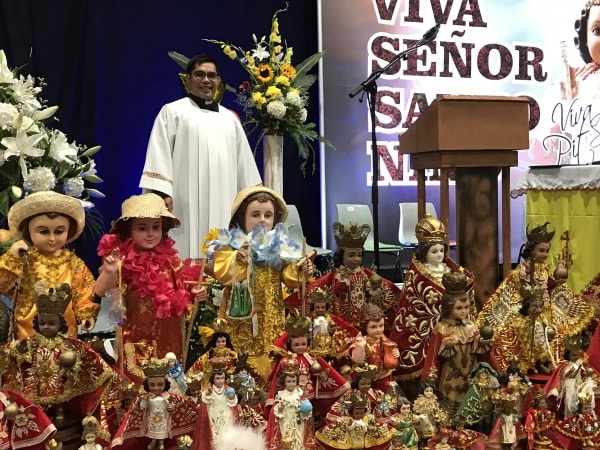The Filipino Catholic community gathered on the North Shore in Auckland on January 20 to mark the 25th anniversary of their devotion to Senyor Santo (Sto) Niño (Holy Child) in New Zealand.
One of the more popular devotions in the Philippines, the Sto Niño is an image of Jesus as a young boy dressed as a king.
In his homily at the Mass, Fr Larry Rustia said the feast reminds the faithful that God, the King, came down as a baby “like each one of us. This is more than a celebration. This is a commitment to our faith in the Child Jesus”, he said.
Fr Rustia celebrated the Mass on behalf of Bishop Patrick Dunn. Other Filipino priests who concelebrated the Mass were Fr Ruben Elago, MSP, Fr Gilbert Ramos (ACFC Chaplain), Fr Sherwin Lapaan, Fr Sam Pulanco and Fr Elric Jorquia.
More than 10,000 people came to celebrate throughout the day, said lead organiser Miriam Batucan. Mrs Batucan and her husband, Oscar, brought the devotion to New Zealand more than 25 years ago.
“The devotion to Sto Niño is what we all can relate to as a community. That is why it is going from strength to strength. New (Filipino) migrants come (to the celebration) because they are already exposed to the novena,” she said.
“I think it (the celebration) is a display of [the] fervent faith of the migrants. When we face challenges, we have one thing we hold on to: our faith in God,”she added.
The January 20 Mass started with a dance by the members of the NZ-Filipino Sto Niño Devotees called Sinulog. Sinulog is a Cebuano word which means “movement like the water current”. The dancers moved two steps forward and one step backward to the beat of
drums. The dance symbolised the conversion of early Filipinos from paganism to Christianity.
In front of the stage were rows upon rows of statues of the Child Jesus which were blessed by Fr Rustia during the Mass.
In Wellington, Cardinal John Dew celebrated the Mass, which he describes as “always a colourful and joyous occasion”.
“This is a wonderful example of the popular piety which Pope Francis describes as having ‘evangelising power’ in Evangelii Gaudium 122-126: “Underlying popular piety, as a fruit of the inculturated Gospel, is an active evangelising power which we must not underestimate:
to do so would be to fail to recognise the work of the Holy Spirit. Instead, we are called to promote and strengthen it, in order to deepen the never-ending process of inculturation. Expressions of popular piety have much to teach us,” Cardinal Dew said.
In the 18th century, Pope Innocent XIII set the day for the feast on the third Sunday of January. The original image is the oldest Catholic relic in the Philippines. It was given as a gift by Portuguese explorer Ferdinand Magellan to local chief Rajah Humabon and
his wife upon their Baptism. This image is currently housed at the Basílica Minore del Santo Niño de Cebú.

Reader Interactions